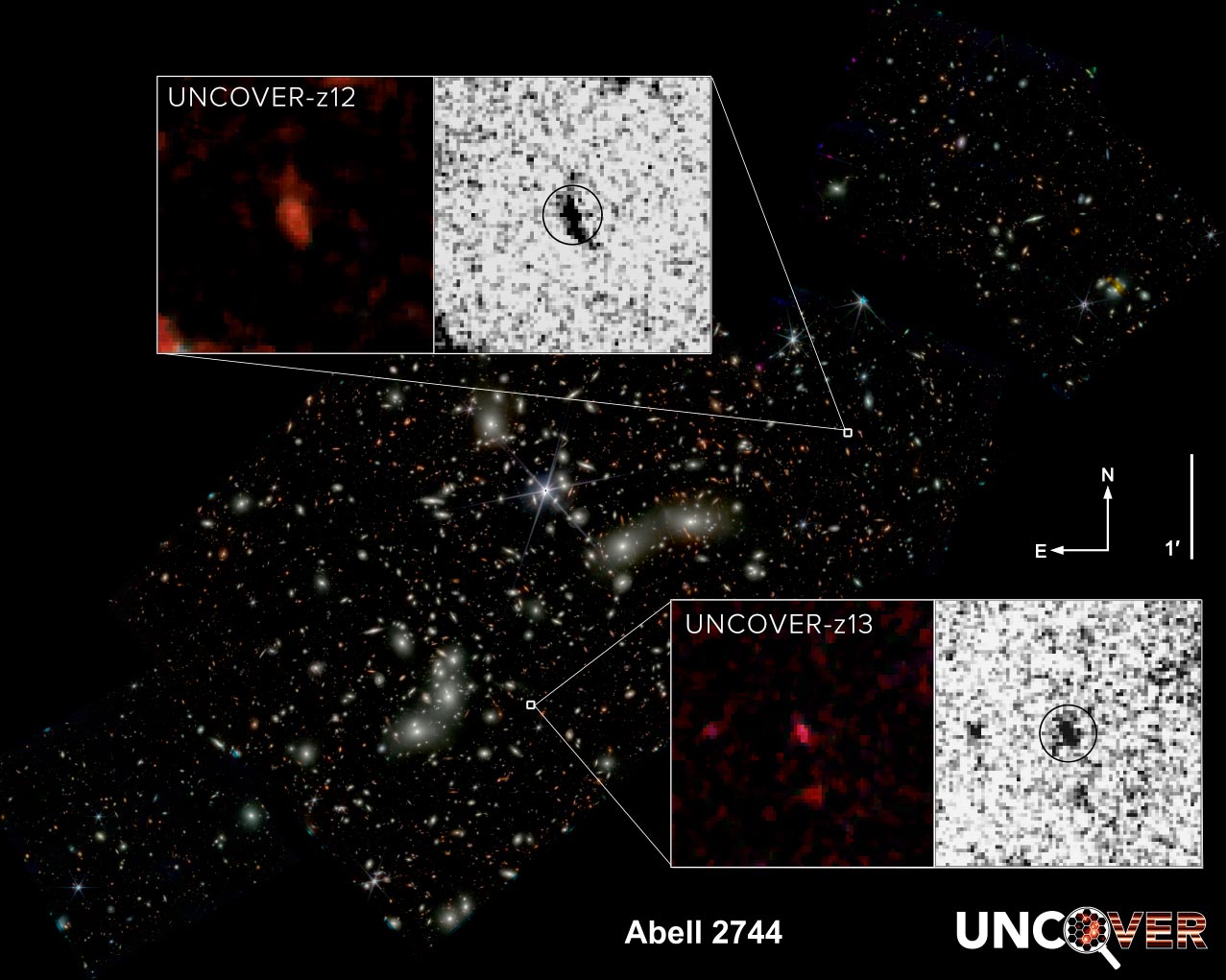
The existence of the second and fourth most distant galaxies ever recorded (UNCOVER z-13 and UNCOVER z-12) has been confirmed using the James Webb Space Telescope’s near-infrared camera (NIRCam). The galaxies are located in the Pandora cluster (Abell 2744), and are shown here as near-infrared wavelengths of light translated into the colors of visible light. The main cluster image is scaled in arcseconds, a measure of angular distance in the sky. The circles in the black-and-white images, showing galaxies in the range of the NIRCam-F277W filter on board the James Webb Telescope, indicate an aperture size of 0.32 arcseconds. Source: Cluster image: NASA, UNCOVER (Bezanson et al., DIO: 10.48550/arXiv.2212.04026) Inserts: NASA, UNCOVER (Wang et al., 2023) Synthesis: Danny Ziemba/Penn State
Subsequent observations in the Pandora cluster confirmed the existence of the second and fourth most distant galaxies ever, larger than other galaxies found at such extreme distances.
The second and fourth most distant galaxies ever discovered were discovered in a region of space known as the Pandora cluster, or Abell 2744, using data from… NASA‘s James Webb Space Telescope (JWST). In a follow-up deep field image of the region (see image below), an international team led by Penn State researchers confirmed the distance of these ancient galaxies and inferred their properties using new spectroscopic data — information about light emitted across the electromagnetic spectrum — from JWST. About 33 billion light-years away, these incredibly distant galaxies offer insight into how the first galaxies formed.
Unique appearance and significance
Unlike other confirmed galaxies at this distance, which appear in images as red dots, the new galaxies are larger and appear like a peanut and a fluffy ball, according to the researchers. A paper describing the galaxies appears today (November 13) in the journal Astrophysical Journal Letters.

Astronomers estimate there are 50,000 near-infrared light sources represented in this deep field image of the Pandora cluster from NASA’s James Webb Space Telescope. Its light traveled varying distances to reach the telescope’s detectors, representing the vastness of space in one image. Credit: Science: NASA, ESA, CSA, Ivo Lappé (Swinburne), Rachel Bezanson (University of Pittsburgh), Image processing: Alyssa Pagan (STScI)
“Very little is known about the early universe, and the only way to learn about that time and test our theories about galaxy formation and early growth is through these very distant galaxies,” said first author Bingyi Wang, a postdoctoral researcher at the University of Pennsylvania. Eberly State College of Science and a member of JWST UNCOVER Team (Ultradeep NIRSpec and NIRCam observations before the reionization era) who conducted the research. “Before our analysis, we knew of only three confirmed galaxies at this extreme distance. Studying these new galaxies and their properties has revealed the diversity of galaxies in the early universe and how much can be learned from them.
Insights into the early universe
Because the light from these galaxies had to travel a long time to reach Earth, it provides a window into the past. The research team estimates that the light discovered by the James Webb Space Telescope was emitted from the two galaxies when the universe was about 330 million years old, and traveled about 13.4 billion light-years to reach the James Webb Space Telescope. But the researchers said that the galaxies are currently closer to 33 billion light-years from Earth due to the expansion of the universe during this period.
“The light from these galaxies is ancient, about three times older than Earth,” said Joel Lyja, an assistant professor of astronomy and astrophysics at Penn State and a member of UNCOVER. “These early galaxies are like lighthouses, light bursting through the very thin hydrogen gas that made up the early universe. It is only through their light that we can begin to understand the strange physics that ruled the galaxy near cosmic dawn.”

Using the James Webb Space Telescope, scientists have discovered two distant galaxies in the Pandora cluster, providing new insights into the early universe. These galaxies, unique in size and appearance, challenge our understanding of galaxy formation in the early universe. Credit: NASA
It is worth noting that the two galaxies are much larger than the three previously existing galaxies at these great distances. One is at least six times larger and is about 2,000 light-years across. For comparison, milky way The galaxy is about 100,000 light-years across, but Wang believes the early universe was very compact, so it’s surprising that the galaxy could be that big.
“Galaxies previously discovered at these distances are point sources. They appear as a dot in our images,” Wang said. “But one of ours looks elongated, almost like a peanut, and the other looks like a thin ball. It’s not clear whether the difference in size is due to how the stars formed or what happened to them after they formed, but the diversity in the properties of galaxies is really interesting. It’s These early galaxies are expected to have formed from similar materials, but they are already showing signs of being very different from each other.
Research Methodology
The two galaxies were among 60,000 light sources in the Pandora cluster discovered in one of the first deep-field images taken by the James Webb Space Telescope during 2022, the first year of science operations. This region of space was chosen in part because it lies behind many galaxy clusters that create a natural magnification effect called gravitational lensing. The gravitational force of the clusters’ combined mass distorts the space around them, focusing and amplifying any light that passes near them and providing a magnified view behind the clusters.
Within months, the UNCOVER team narrowed down the 60,000 light sources to 700 candidates for follow-up study, eight of which they believed could be among the first galaxies. Then, the James Webb Space Telescope pointed again at the Pandora cluster, recording the spectra of the candidates, a kind of fingerprint that details the amount of light emitted at each wavelength.
“Several different teams are using different methods to search for these ancient galaxies, each with their own strengths and weaknesses,” Leija said. “The fact that we’re pointing this giant magnifying glass into space gives us an incredibly deep window, but it’s a very small window so we were rolling the dice. Many of the candidates were inconclusive, and at least one of them was a case of mistaken identity. It was something much closer.” “It simulates a distant galaxy. But we were lucky, and two of them turned out to be these ancient galaxies. It’s incredible.”
Properties and effects
The researchers also used detailed models to infer the properties of these early galaxies when they emitted light detected by the James Webb Space Telescope. As the researchers expected, the two galaxies were young, had little metal in their composition, were growing rapidly and actively forming stars.
“The first elements were formed in the cores of early stars through the process of fusion,” Lyga said. “It stands to reason that these early galaxies did not have heavy elements such as metals because they were among the first factories to build those heavy elements. Of course, they would have to be young and forming stars to be the first galaxies, but confirming these properties is an important fundamental test of our models and helps in Confirm the complete model of galaxies. the great explosion theory.”
Combined with gravitational lensing, the James Webb Space Telescope’s powerful infrared instruments should be able to detect galaxies at a farther distance, if they exist, the researchers noted.
“We had a very small window into this region, and we didn’t observe anything outside of these two galaxies, even though the James Webb Space Telescope has the ability,” Leja said. “This might mean that galaxies didn’t form before then, and that we wouldn’t find anything farther out. Or it might mean that we just weren’t lucky enough because of our small window.”
This work was the result of a successful proposal submitted to NASA proposing how the James Webb Space Telescope could be used during its first year of science operations. In the first three rounds of submissions, NASA received four to ten times more proposals than the observing time available on the telescope would allow, and had to select only a portion of those proposals.
“Our team was very excited and a little surprised when our proposal was accepted,” Leija said. “It involved coordination, quick human action, and pointing the telescope at the same object twice, which is a lot to ask of a telescope in its first year. There was a lot of pressure because we only had a few months to decide what things to pursue. But it was created The James Webb Space Telescope is working to find these first galaxies, and it’s very exciting to do so now.
Reference: “Detection: Shedding Light on the Early Universe — JWST/NIRSpec Confirmation of z>12 Galaxy” by Benjie Wang, 冰洁王, Seiji Fujimoto, Ivo Lappé, Lukas J. Furtak, Tim B. Miller, David J. Seaton, Adi Zittrain, Hakim Atiq, Rachel Besançon, Gabriel Brammer, Joel Leja, Pascal A. Osch, Sedona H. Price, Irina Chemerinska, Sam E. Cutler, Pratika Dayal, Peter van Dokkum, Andy de Golding, Jenny E. Green, Y. Vodamoto, Gaurav Khullar, Vasiliy Kokorev, Danilo Marchesini, Richard Pan, John R. Weaver, Katherine E. Whitaker and Christina C. Williams, November 13, 2023, Astrophysical Journal Letters.
doi: 10.3847/2041-8213/acfe07
In addition to Penn State, the team includes researchers from the University of Texas at Austin, Swinburne University of Technology in Australia, Ben Gurion University of the Negev in Israel, and Ben Gurion University of the Negev in Israel. Yale UniversityUniversity of Pittsburgh, Sorbonne University in France, University of Copenhagen in Denmark, University of Geneva in Switzerland, University of Massachusetts, University of Groningen in the Netherlands, Princeton UniversityWaseda University in Japan, Tufts University, and the National Laboratory for Optical and Infrared Astronomy (NOIR) Research.
This work was supported by NASA, the US-Israel Bi-Science Foundation, the US National Science Foundation, the Israeli Ministry of Science and Technology, the French National Center for Space Studies, the French National Institute of Geosciences and Astronomy, and the Research Center. The Foundation for the Advancement of Science, the Netherlands Research Council, the European Commission and the University of Groningen in joint funding of the Rosalind Franklin Program, the National Astronomical Observatory of Japan, and the NOIR Laboratory.

“Web maven. Infuriatingly humble beer geek. Bacon fanatic. Typical creator. Music expert.”

:quality(85)/cloudfront-us-east-1.images.arcpublishing.com/infobae/4OGKYRHJX5HQ7GWNLLKJOED5XM.png)



More Stories
The Starliner launch was delayed to mid-May
Boeing Starliner launch delayed until at least May 17 – Orlando Sentinel
The near collapse of Earth’s magnetic field 591 million years ago may have allowed complex life to flourish